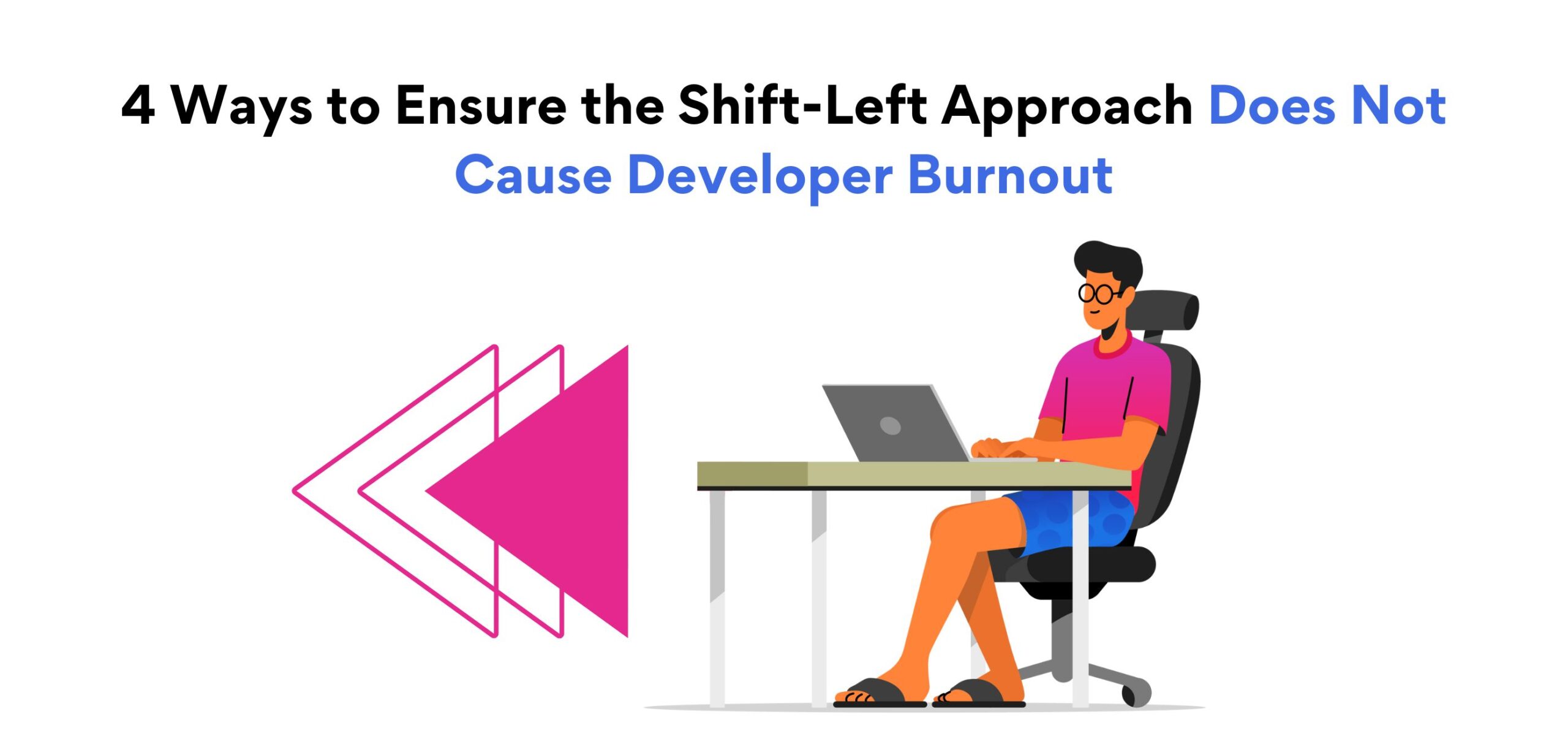Metaverse Guide: What Is the Metaverse? Here’s What You Need to Know
Imagine sitting on your couch but exploring the beautiful city of Las Vegas. You’re meeting new people, engaging in exciting activities, and even purchasing souvenirs without actually being there. But all of this is happening virtually, in the Metaverse! Keep reading this Metaverse guide to learn more.
As we know, the Metaverse has been making waves in the digital world in recent years. Many experts believe that it could be the next major shift in technology. But what exactly is this Metaverse? In this Metaverse guide, we will cover everything about this emerging concept, right from what it is and how it works, to its potential impact on society. And last but not least, we’ll also cover how to become a Metaverse developer. Let’s get started!
What is the Metaverse?
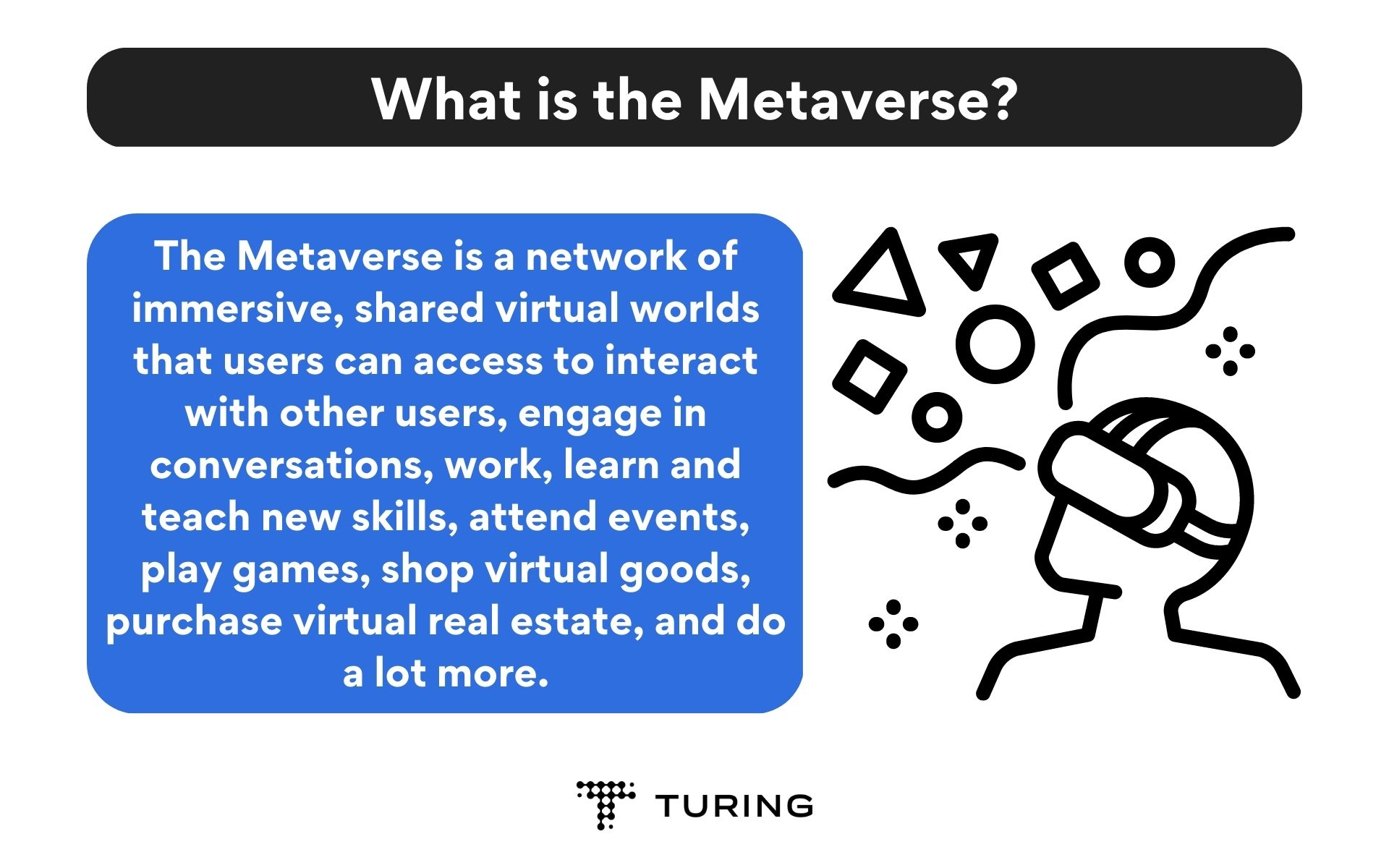
Metaverse Guide: What is the Metaverse
The Metaverse is, what many in the tech sphere believe, the next version of the internet: a shared, singular, immersive 3D virtual space where humans can experience life without physically moving from one place to another.
In other words, the Metaverse is a network of immersive, shared virtual worlds that users can access to interact with other users, engage in conversations, work, learn and teach new skills, attend events, play games, shop virtual goods, purchase virtual real estate, and do a lot more. You can imagine the Metaverse technology as a ‘cyberspace’ – a three-dimensional, evolved internet – where logging in isn’t required.
The concept of the Metaverse was first mentioned in Neal Stephenson’s science novel, “Snow Crash,” published in 1992. Stephenson, in his novel, envisioned a virtual universe where users could use virtual reality (VR) headsets to enter with their digital avatars. This concept was again popularized in Earnest Cline’s 2011 sci-fi novel Ready Player One, where individuals use VR headsets to enter a virtual world.
Metaverse has yet to develop fully, but it quickly rose to popularity when Facebook rebranded itself to Meta in 2021 and announced its plans to invest $10 billion in the Metaverse concept. Since then, other tech giants like Microsoft, Google, Sony, and Nvidia have also invested billions of dollars into the same. Let’s see how.
- Facebook (now Meta) – Facebook has been heavily involved in the VR space for a long, releasing devices like the Oculus that offer a seamless VR experience. Now, Meta is also focusing on the Metaverse’s software aspect with the newly built Horizon Marketplace, which allows users to purchase and sell goods virtually.
- Google – Google has been an early player in the AR space with its Google Glass, which wasn’t made mainstream for the public but did become successful in the private sector. In 2021, Google merged its AR and VR departments under the ‘Google Labs’ label, and this new team is now working towards Project Starline, a holographic video conferencing technology.
- Nvidia – Given Nvidia’s global reputation as one of the top players in digital design, the company is using its position to accelerate efforts toward Metaverse development. For this, Nvidia is handing out a free version of its Omniverse software suite to individual artists. This suite contains the required tools to help designers create full-fledged virtual assets and worlds, which they can even put up on digital content libraries and marketplaces.
- Sony – Alongside Epic Games, Sony has been one of the biggest but silent players in the Metaverse. Sony’s efforts towards the Metaverse began with a simple game called Fortnite, which went from being a battle royal game to a full-fledged virtual world where players can socialize, play, and also attend virtual performances.
What does the Metaverse comprise?
Today, the Metaverse comprises ten layers under four key categories: content and experiences, platforms, hardware and infrastructure, and enablers. Here’s what these layers entail.
-
Content and experiences
-
- This includes the content developed by creators, developers, and users which establishes and enriches the Metaverse experiences.
- It also involves virtual worlds where users can gather, interact, create, and engage in other activities.
- Last but not least, it includes applications required for Metaverse use cases, such as events or learning sessions.
-
Platforms
-
- Platforms made for creators who will create 3D experiences.
- Platforms that help access and discover content, applications, and experiences.
-
Hardware and infrastructure
-
- The Metaverse is built on underlying infrastructure like semiconductors, cloud computing, networks, and more.
- Users access and interface with the Metaverse using various devices (AR/VR headsets), accessories, and operating systems.
-
Enablers
- Applications and tools to manage digital identity.
- Privacy, security, and governance are key to the Metaverse’s fair and proper functioning.
- Tools that can help users access the Metaverse economy through monetization and payments.
How does the Metaverse work?
You can envision the Metaverse as a visually represented internet. But here’s the best part. You can actually enter the Metaverse instead of just looking at it.
The Metaverse leverages various technologies such as virtual reality (VR), augmented reality (AR), blockchain, and others to create a seamless and immersive user experience. In addition, devices like VR headsets and AR glasses project the Metaverse around you. Let’s delve a little deeper into this to better understand how the Metaverse works.
-
Creating the virtual experience
To build a virtual environment for experiences like participating in events, socially interacting via platforms, or playing games, one would need to use Web3 development and 3D designing libraries like libp2p, three.js, light.js, web3.js, web3j, ethers.js, and web3.py.
Selecting which library to use depends on the type of experience one wants to create for the users. Today, three.js is one of the most popular choices for Web3 designers, which uses scenes, cameras, effects, meshes, animations, and render performance monitoring. -
The importance of discovery tools
Once a virtual experience is created, discovery tools such as search engines can be created using extended services over the Metaverse. These would allow users to interact virtually with the search result via augmented reality (AR).
For instance, let’s say you want to build a VR platform that offers real-time navigation through suggestions and directions via the user’s camera. For this, you would need spatial computing through geo-tagged tokens on OSM (OpenStreetMap) data points, Blockchain, and Metaverse elements that operate the same way as 3D designing for AR. -
The role of virtual reality devices
Once the virtual environment is created and the discovery tools are ready, VR comes into play, where users can actually experience the Metaverse. Users can enter the virtual environment with 360-degree vision using a virtual reality headset or other immersive technologies.
Moreover, users can create their avatars, i.e., digital representations of themselves in the Metaverse. These avatars can be customized to reflect the user’s appearance, attire, and preferences. In other words, virtual reality technology enables you to get a fully immersive experience in the Metaverse by creating a sense of presence and realism. -
The need for virtual currencies
The growing popularity of the Metaverse has also increased the need for virtual currency. This is a digital currency that we can use to purchase goods and services in the Metaverse. You can get virtual currencies by exchanging real money at cryptocurrency exchanges like Binance, Coinbase, and others. You can also connect your wallets to these platforms to carry out transactions.
Virtual reality use cases in the Metaverse
The combination of VR and the Metaverse can prove to be extremely useful for several industries. Here are some examples:
- Travel – Using VR, people can travel virtually to almost any place through the Metaverse, be it monuments, popular cities, must-visit eateries, or even local spots that are unique to each city.
- Games – VR-based games are already popular and many tech giants are investing in exploring this foray even deeper. In the future, users can even connect with one another in the Metaverse and experience next-level immersiveness through VR headsets, playing with their friends from anywhere in the world.
- Medicine – VR and Metaverse can also be significant to the healthcare industry. Medical doctors, practitioners, and students can use VR to perform digital surgeries on digital avatars in the Metaverse, as a new and more efficient form of practice. This will further help newcomers of the industry to sharpen their skills and be better professionals down the line.
- Education – VR can also play in evolving the education sector for better learning experiences. Teachers can use VR-supported devices to make lessons more immersive and engrossing for students. Plus, VR can be implemented to explain concepts virtually through diagrams, interactive content, and more. Virtual tours in the Metaverse can also be used to explain lessons in history, science, and other areas.
- Military – Forces can use the Metaverse to conduct simulated training sessions where soldiers can better train for combat situations using appropriate AR/VR gear.
- Virtual events – One of the most obvious use cases of VR in the Metaverse is the ability to hold events virtually, allowing participants worldwide to attend or experience them. In the long run, this can make event hosting more time-saving and cost-friendly than ever.
Why is the Metaverse important?
Given how AR, VR, XR (extended reality), MR (mixed reality), and various other virtual-oriented devices and platforms are already discovering use cases for the Metaverse, its importance can’t be underestimated. Companies are increasingly working towards building roadmaps to evolve and mix reality better than ever. Let’s take a look at why Metaverse has quickly become the center of attention for many.
-
User interaction improvement
Using VR or AR, businesses can leverage the Metaverse to offer better consumer support through digital avatars acting as virtual agents/assistants. Companies can use even use games, galleries, VR/AR showrooms, VR tours, interactive case studies, and various other methods to generate new users through the Metaverse and be at the top of their game. -
Better advertisement experience
Print ads are now outdated, and even social media ads are something many users simply skip. The Metaverse can help revive the highly lucrative advertisement landscape by enhancing the interaction with an ad. Companies can use dynamic ads, interactive ad components, and 3D elements to attract more customers and let them better engage with their products/services. -
Corporate events
Businesses were already hosting business conferences, webinars, and seminars through online platforms like LinkedIn, YouTube, Facebook, etc. Now, the Metaverse can help elevate the experience by letting employees virtually attend the conference as their digital avatars, actively engaging in discussions, interactions, and even giving presentations more immersively. -
Better e-commerce experience
Using AR and VR in the Metaverse, brands can completely change the way shoppers and consumers interact with their products. For instance, a shoewear brand can let users try out various shoes by trying them on virtually. This intriguing experience can also help companies nudge the user to purchase their products by offering a brilliant shopping experience.
Brands like IKEA, Warby Parker, and Glasses.com have already implemented AR into their e-commerce platforms. These allow consumers to explore products from the comfort of their homes and experience how a product would actually look and feel once they purchase it, in a way they never have before. -
Better operations
Metaverse concepts can also assist companies in establishing more productive and efficient operations. This will allow companies to not only build better products, but also enhance their maintenance cycles, find defects/bugs/issues quicker, and expedite their time to market.
A good example of this would be BMW. The automobile giant currently has an all-electric vehicle production line that it ran solely as a simulation for roughly six months. For this, BMW built virtual cars on a 1:1 scale in the Metaverse to explore all their options before determining the factory’s final layout.
How to access the Metaverse?
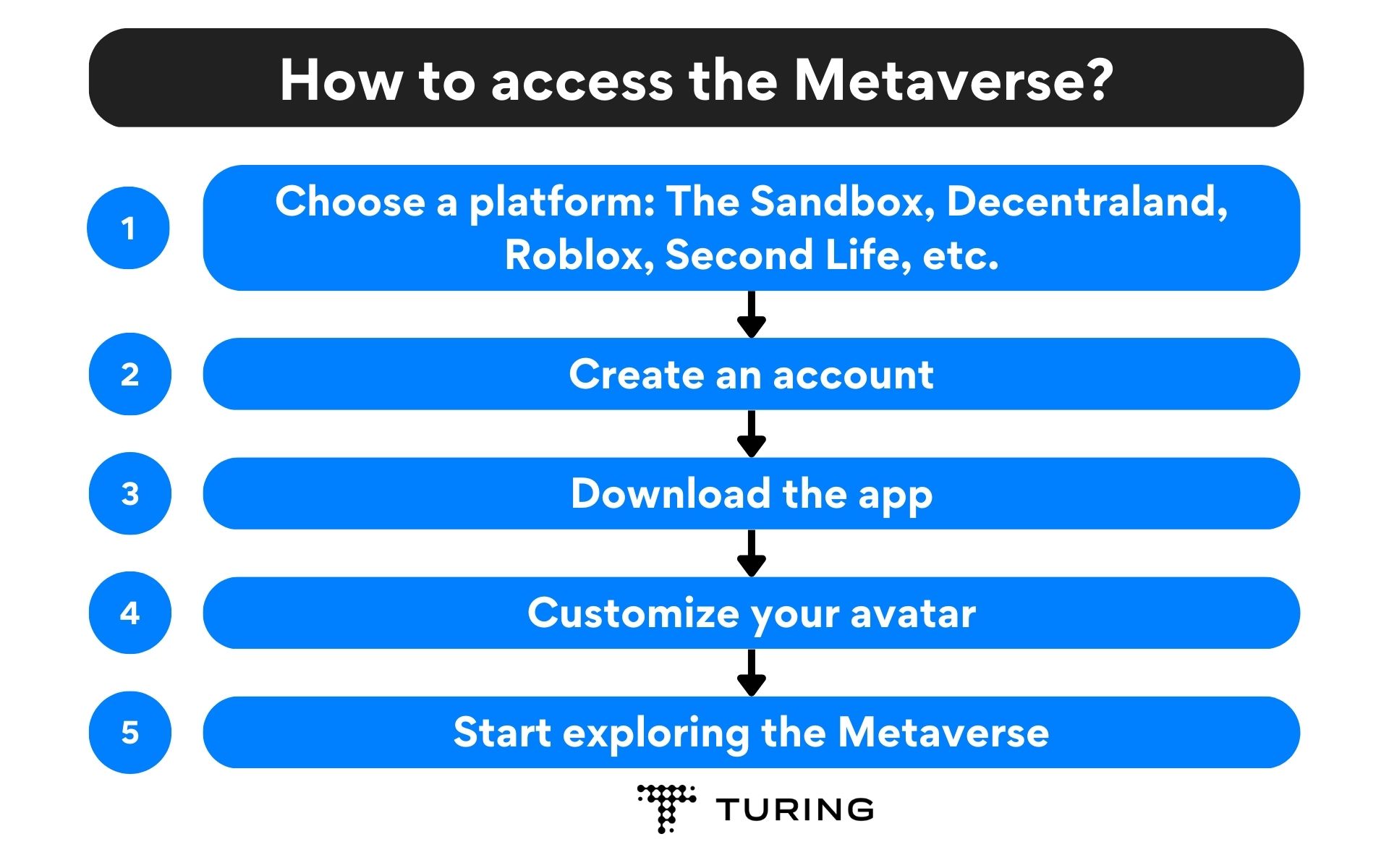
Metaverse Guide: How to access the Metaverse
While Metaverse is still in its early stages, users can access this immersive virtual world using specific steps and devices. Our detailed Metaverse guide covers both so you can easily access the Metaverse and enjoy the experience. Let’s dive in!
Devices to access the Metaverse
As of today, there isn’t a singular entrance into the Metaverse as the idea of just one Metaverse is still theoretical. However, those who want to experience the Metaverse can do so by using the following devices.
- VR headsets – VR headsets are one of the most common devices today to access the Metaverse. Wearing it, you will receive a digital display of the Metaverse virtual world. A VR headset tracks your head positioning, meaning your POV will change in the virtual world whenever you look around, the same way it would in the real world. Oculus is a prominent player in this space, who had first launched their line of VR headsets in 2012. Their latest release, the Oculus Quest 2, is a major example of a Metaverse device as it boasts impressive VR tech with both PC and Android compatibility.
- Gaming consoles – Prominent gaming consoles like the PlayStation and Xbox already allow users to access the Metaverse in some way or the other. For instance, the Xbox, despite not having any AR or VR support, provides platforms such as an interactive “metaverse museum” and Roblox, where a virtual world can be entered. PlayStation also comes with a PlayStation VR headset to access VR features, which has now become an intriguing platform to develop Metaverse features in.
- Smartphones – Just like gaming consoles, Roblox also works on iOS, Android, and other mobile platforms, allowing smartphone users to enter the virtual world. Roblox comes with VR support as well, meaning you can use your phone to access a virtual world, the same way others do with expensive PC setups.
- AR gear – Augmented reality gear is another way to access the Metaverse. It’s similar to VR devices in that both put digital imagery to your point of view. However, a key difference is that AR gear overlays Metaverse elements on top of the real world you see, whereas VR entirely replaces your POV with a virtual landscape. Microsoft HoloLens and Google Glass are some of the most prominent AR gear examples that have been developed to access the Metaverse.
- Computers – While not the most user-friendly, computers are one of the most powerful options for accessing Metaversal systems. Most of the programs for accessing the Metaverse run on computers. However, your computer would require a good GPU and an accompanying VR/AR system to let you access the Metaverse.
Steps to access the Metaverse
Accessing the Metaverse depends on the specific platform you want to enter. Here are the common steps to help you get started:
- Choose a platform: Today, multiple Metaverse platforms are available out there, such as the ones we’ve mentioned above: The Sandbox and Decentraland. Plus, you can also experience the Metaverse through other platforms like Roblox, Second Life, and Axie Infinity.
- Create an account: Once you choose a platform, you need to create an account. Provide your email address and create a username and password. Some platforms may ask for additional information, such as age or location.
- Download the app: Depending on what platform you choose, you may need to download their app to access the Metaverse. Follow the instructions shared by the provider to install the necessary software.
- Customize your avatar: Almost every Metaverse platform requires you to create an avatar that represents you in the virtual world. You can customize the avatar according to your appearance and personality.
- Start exploring the Metaverse: Once you create your account and the avatar, you can access the Metaverse. You can interact with other users, make friends, explore different virtual locations, shop, and discover everything Metaverse offers.
How do NFTs fit into the Metaverse landscape?
As we covered in the previous section, NFTs are quickly gaining traction in the virtual tech space. In a nutshell, non-fungible tokens (NFTs) are secured digital assets that operate on the same blockchain technology cryptocurrencies do. While cryptocurrencies represent financial currency, NFTs represent art, music, or even digital real estate that the owner can purchase or sell in the Metaverse.
The Metaverse Group is the world’s first real estate company to operate virtually. The Group helps buy or rent real estate in Metaverse virtual worlds like Sandbox, Decentraland, Upland, and Somnium. Users can get spaces for commercial and conference uses, purchase land for art galleries, houses, and even spots to hang out with friends and family. These are all done through NFTs, and the more they are normalized, the more types of real estate people will get to access.
New-age companies aren’t the only ones riding on this virtual wave. Prominent brick-and-mortar brands are doing the same, such as Nike, who acquired a started called RTFKT, which makes unique virtual sneakers and digital collectibles through NFTs, AR, and blockchain authentication. Before this acquisition, Nike even filed trademark applications to create virtual apparel and sneakers consumers can buy virtually. Roblox and Nike have also collaborated to create a digital world called Nikeland, where Nike consumers and fans can connect, play games, and dress up their avatars in virtual Nike apparel.
Hence, it’s becoming evident that alongside blockchain, NFTs form the foundation for virtual ownership. As people become accustomed to the Metaverse, NFTs will be the vehicle through which their real-world goods’ ownership will transform to digital ownership, which will be critical to ultimately interacting in the Metaverse.
Metaverse pros and cons: What are the potential benefits and drawbacks of the Metaverse?
As we’ve discussed here, the Metaverse is a key technological advancement and hence, has attracted many eyeballs. It has the potential to offer many benefits, but it’s not perfect and does also come with certain drawbacks. Let’s take a look at some of the most important Metaverse pros and cons.
Metaverse pros
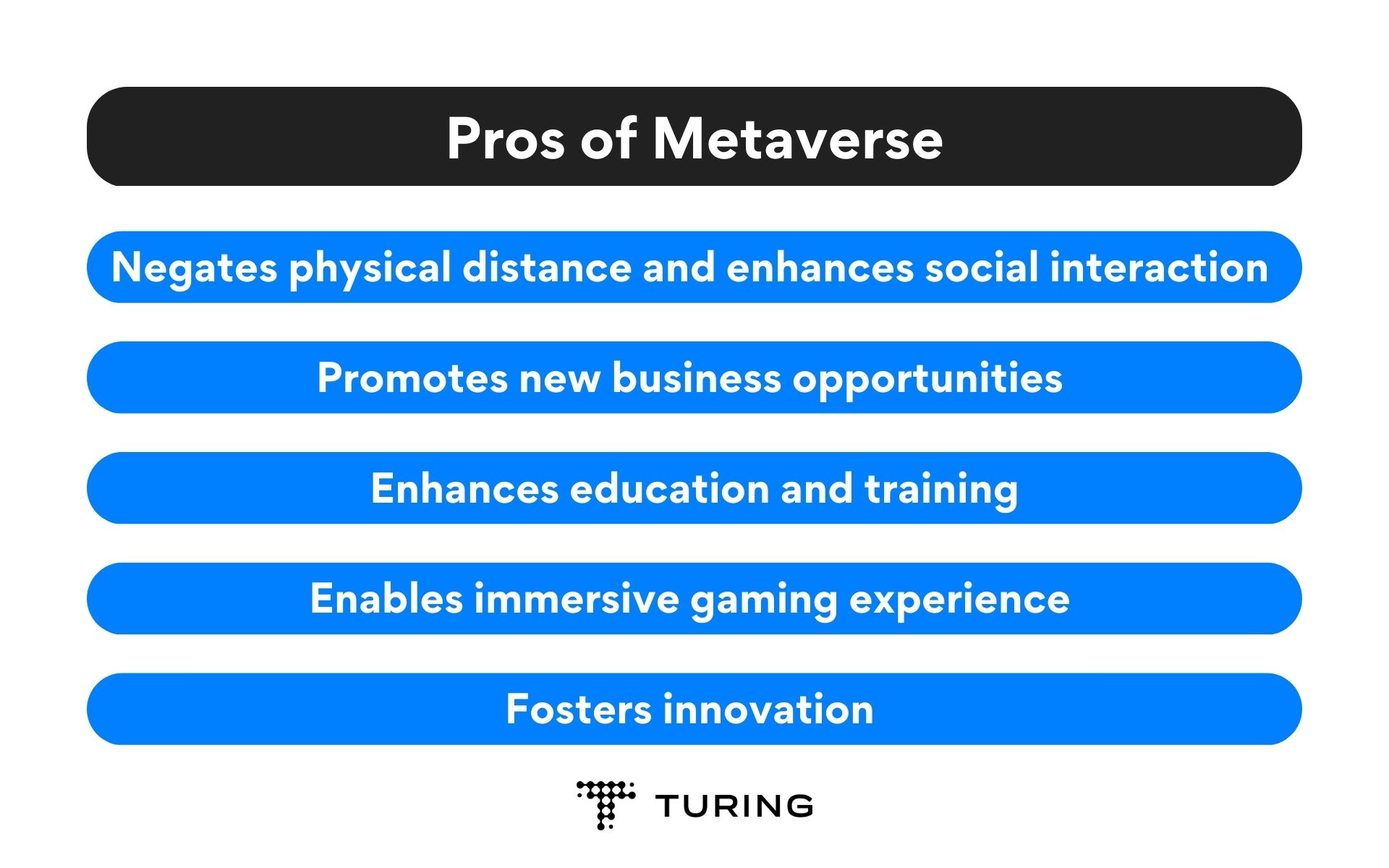
Metaverse Guide: Pros of Metaverse
Let’s quickly take a look at some of the pros Metaverse offers
-
Negates physical distance and enhances social interaction
When you are in the Metaverse, your geographic location becomes irrelevant. The Metaverse allows you to connect with people from across the globe in a super interactive and immersive way. Unlike social media platforms, where you can only hear and see someone, Metaverse allows you to engage with your friends in activities such as gaming, shopping, and attending events together through your avatar. -
Promotes new business opportunities
The Metaverse can create new business opportunities, allowing companies to advertise and sell virtual goods and services. You can see the products and even feel them using haptic technology. -
Enhances education and training
Metaverse will further improve the current online education. With the Metaverse, quality education will be accessible to everyone, irrespective of their physical location. People from any part of the world can teach and learn together in real time, just like in a physical classroom. -
Enables immersive gaming experience
The Metaverse can create highly immersive gaming environments that allow the players to get fully engrossed in the game. It provides detailed and realistic environments where gamers feel they are interacting with other players physically. -
Fosters innovation
The Metaverse can foster innovation because creating immersive and interactive environments will require new technologies. This will encourage innovation in areas like game development, content creation, marketing, and more.
Metaverse cons
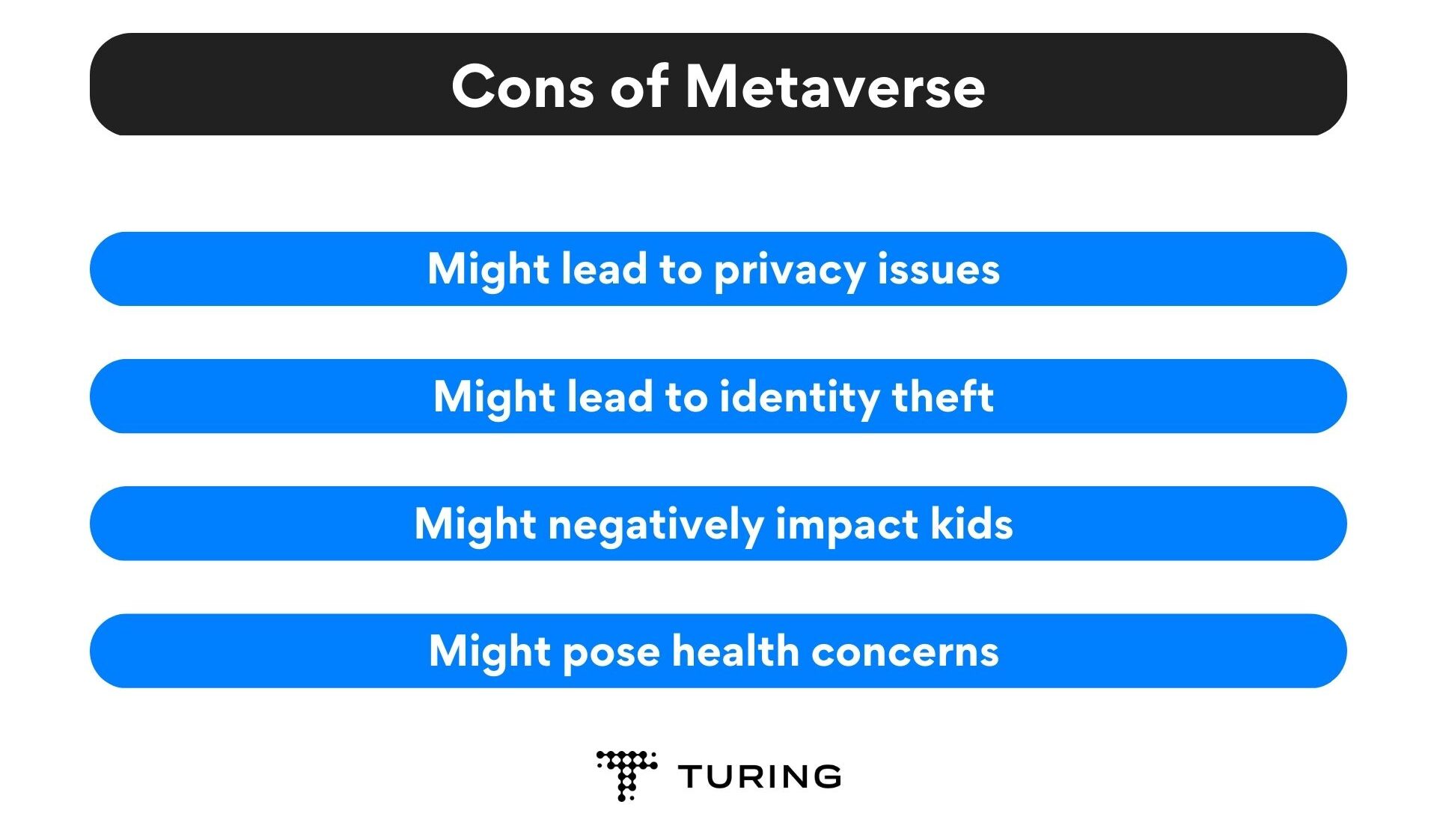
Metaverse Guide: Cons of metaverse
Now that we’ve covered the pros, let’s go over the cons.
-
May lead to privacy issues
Metaverse platforms usually collect users’ facial attributes, blinks, and personal information like name, location, browsing behavior, and other details. Businesses can use this data for targeted advertising and other purposes, raising concerns about our privacy. -
May lead to identity theft
Hackers and miscreants can hack your avatars and pretend to be you in the Metaverse. They can also misuse your sensitive data and get you in trouble. -
May negatively impact kids
The internet is often cited to have an adverse effect on kids. Many people consider the Metaverse to be the next version of the internet. They fear that the new platform may cause physiological and psychological risks for young minds. Moreover, children may also come across sexual and other harmful content on such platforms, which can negatively impact them. -
May pose health concerns
Just like the internet, the Metaverse can be very addictive, impacting our physical and mental health. Science has concrete evidence that excessive use of digital devices causes mental health issues such as depression, losing interest in social activities, paranoid ideation, psychoticism, etc. Spending hours in the Metaverse can increase the risk of obesity, heart disease, diabetes, and other health issues. Moreover, prolonged use of VR headsets can cause eye strain, headaches, etc.
Also, read What Is Programmer Imposter Syndrome and How Can You Deal With It?
When will a full-fledged Metaverse be available?
As discussed earlier, Metaverse is still in its early stages. The primary idea of entering and engaging in a virtual world has existed for many years, but a full-fledged Metaverse where realistic interactions can occur will take some time to develop.
Many experts and tech moguls have spoken similarly about the Metaverse and truly accessing a virtual world. For instance, Microsoft co-founder Bill Gates, in his yearly review blog, stated that many don’t possess the required motion capture gloves and VR goggles to precisely map and represent their body language, voice quality, or facial expressions.
Gates also noted that things would be different for businesses. In the next two to three years, the majority of virtual meetings will move from physical offices to the Metaverse, a 3D world where participants will attend as their digital avatars.
What will the Metaverse’s impact be on the future?
Since Metaverse is not a reality yet, many possibilities and unknowns surround it. How a full-fledged Metaverse will come about, who will control it, and what it will entail is all up for debate. Having said that, many believe in the Metaverse’s capability to enhance our lives by enabling interactions not possible in the physical world.
A recent Accenture survey indicated the same opinion Gates mentioned about the Metaverse affecting the business sphere. The survey, conducted on 4,600 technology and business leaders, found that 71 percent of the people think that the Metaverse will positively impact their company, while 42 percent believe that it will be a major breakthrough.
Moreover, in 2022, Pew Research Center partnered with Elon University’s Imagining the Internet Center to survey 624 business leaders, technology innovators, and activists. This survey was conducted to get their response on Metaverse’s impact by 2040. As per the report, 54 percent of individuals expect the Metaverse to be a fully-functioning, completely immersive aspect of everyday life for half a billion or more people worldwide, while 46 percent said that wouldn’t be the case.
Despite the Metaverse being a relatively new concept, many reports, including the ones mentioned above, suggest how many believe in its potential to enhance human interaction. Plus, other key facets suggest how Metaverse will affect the future, such as:
- The Metaverse will result in constant technological improvements, especially in large-data processes like graphics rendering and computing power. This will help build even bigger virtual worlds that people can access easily through their smartphones, especially after the rapid adoption of 5G.
- Metaverse’s capabilities in shaping future VR/AR technologies is also resulting in the decrease of production costs of VR and AR hardware. Hence, these gears will become more accessible to the public. Plus, tech firms are working on bringing new devices to the market, such as bodysuits and haptic gloves, to further enhance how users engage with the Metaverse.
- As discussed earlier, gaming in the Metaverse is already becoming mainstream. However, Metaverse’s expanding use cases will increase its accessibility, with immersive sports, retail, educational, and other experiences becoming more available. Metaverse will also likely expand its use cases in the corporate sector, with team collaborations, employee training, team one-on-ones, etc. moving to the virtual space.
- The examples of Bitcoin and Ethereum prove how cryptocurrencies are already becoming the norm in many cases. As a result, commerce in the Metaverse will also become more mainstream, as cryptocurrency will be needed to buy and sell goods virtually. The emergence of NFTs is the biggest proof currently that making and selling goods virtually is possible and will indeed increase as the Metaverse takes its full form.
In a final note on Metaverse’s impact in the future, we can consider McKinsey’s recent report which states that the Metaverse may amass nearly $5 trillion within 2030, via enterprise and consumer use cases. Hence, the Metaverse future looks quite promising as this new-age technology will radically develop the internet we use today.
How to become a Metaverse developer?
The Metaverse has become a hot topic in recent years. Naturally, the demand for Metaverse developers is growing. It’s an exciting time for developers looking to build their careers in the Metaverse space. This Metaverse guide lists the steps to becoming a Metaverse developer.
What does a Metaverse developer do?
A Metaverse developer designs and develops interactive and immersive experiences for a virtual world. They write, debug, and execute code for the Metaverse platform. Their responsibilities include:
- Creating immersive and engaging 3D environments using tools such as Unreal Engine, Unity, etc
- Designing user interfaces that allow users to interact efficiently with the Metaverse
- Developing programming logic to support immersive and interactive experiences on the Metaverse
- Implementing security measures to ensure security on the Metaverse
- Collaborating with other developers and stakeholders to plan and implement new features for the Metaverse
- Monitoring performance and troubleshooting to optimize performance
- Learning emerging technologies for the Metaverse development
What skills do you need to become a Metaverse developer?
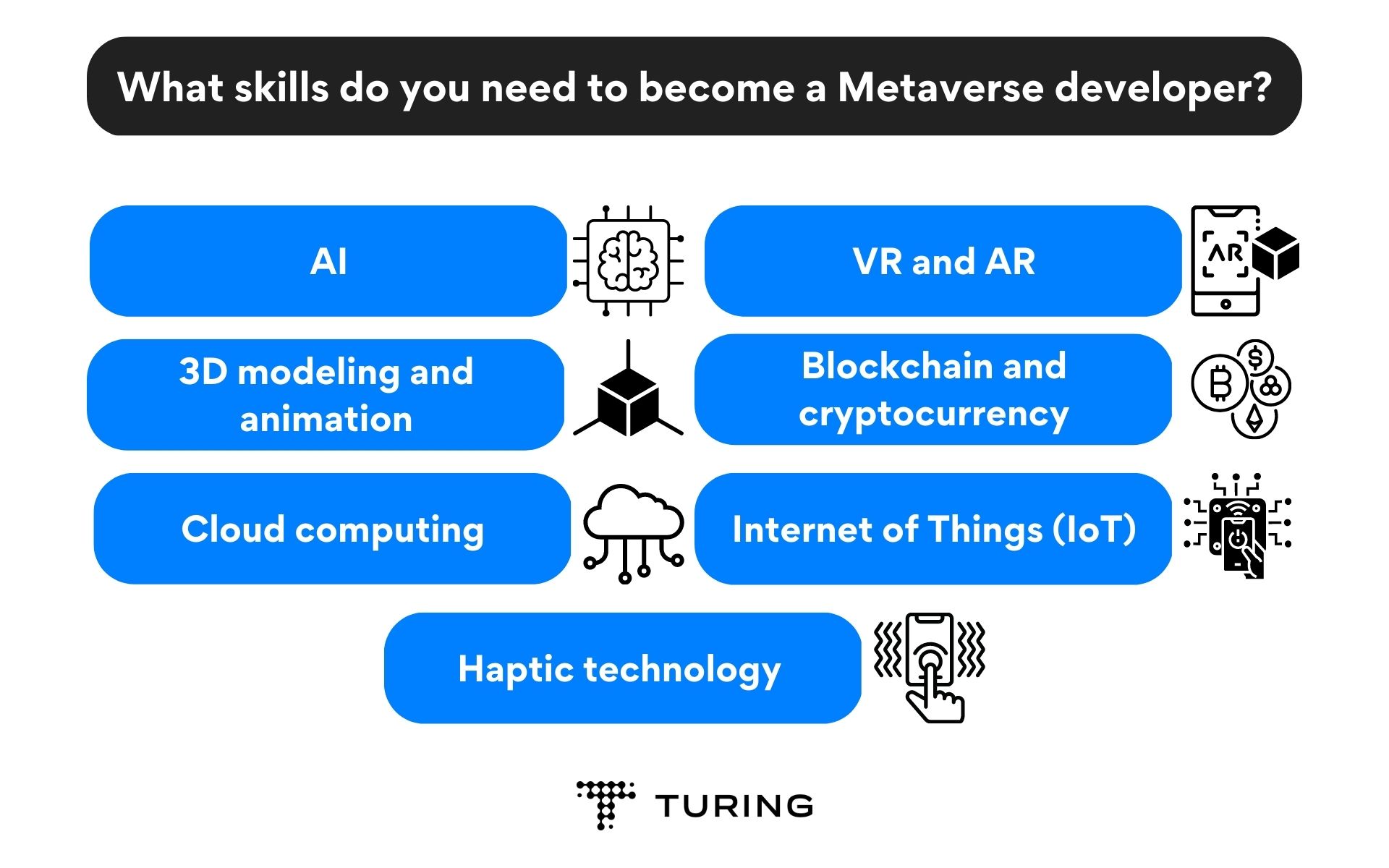
Skills needed to require a Metaverse developer
Metaverse development demands strong programming and problem-solving skills. Let’s look at the seven Metaverse developer skills that can help you become a good Metaverse developer.
-
Artificial intelligence
The application of artificial intelligence (AI) has increased exponentially in recent years. From healthcare to business strategy planning, and surveillance, AI has made a significant impact in every industry. In the case of Metaverse, AI is used to provide a personalized experience and to create intelligent non-player characters. AI is also used to create and customize your digital avatars. You need to be proficient in languages such as Python, R, and C++ to develop efficient AI models. -
Augmented reality (AR) and virtual reality (VR)
The immersive experience is one of the most important features of the Metaverse, which is possible through technologies like virtual and augmented reality. These technologies are used to create immersive virtual environments that enable users to explore different elements using various AR and VR glasses and other input devices.
AR applications allow users to view their surroundings with interactive visuals like the mobile game Pokémon GO. On the other hand, VR produces a computer-generated virtual environment that you can explore using VR headsets, sensors, and gloves. -
3D modeling and animation
Creating a digital environment that appears much like the real world is one of the major challenges in developing the Metaverse, and thus, an important Metaverse developer skill. 3D reconstruction enables you to create a virtual replica of the physical world with natural-looking spaces. Software like Maya, Blender, and Unity is used to create 3D models and animations. -
Blockchain and cryptocurrency
Blockchain is one of the most important technologies for the Metaverse. It is used to create decentralized virtual economies within the Metaverse, allowing users to buy and sell virtual assets. Blockchain technology provides the security and transparency necessary for the Metaverse.
You can use cryptocurrencies in the Metaverse, as the platform does not support physical currencies. Cryptocurrencies use blockchain technology; you must master it as a Metaverse developer. -
Cloud computing
Metaverse will require a lot of storage space to handle the massive data volume. Cloud computing technology comes in handy in creating storage space for the Metaverse. -
Internet of Things (IoT)
The Internet of Things (IoT) is a technology that uses sensors and devices to connect elements of the physical world to the Internet. In the case of the Metaverse, IoT is useful in collecting data and feeding it to the Metaverse to adjust accurately to real-world conditions. -
Haptic technology
This technology is used to create a sense of touch and motion in a virtual environment. It uses sensors and specialized actuators to simulate various sensations, such as vibrations, pressure, and temperature.
Now that we’ve covered the most important Metaverse developer skills, let’s see how you can land a Metaverse job.
How to get a job in the Metaverse?
Once proficient in the above technologies, you can start looking for jobs. Tech giants like Meta, Microsoft, and many startups often hire Metaverse developers. You can look at their career pages and on job sites such as LinkedIn, Indeed, and Glassdoor for open positions.
However, these traditional ways of looking for Metaverse developer jobs can be tedious and may take time. Moreover, you may not find the right opportunity you are looking for. Turing can help you find the best Metaverse developer jobs quickly.
If you’re a developer looking for long-term remote AI and ML jobs with top US companies, try Turing. Earn salaries higher than the market average and enjoy fantastic career growth. Head over to the Apply for Jobs page for more information.
Final thoughts
The Metaverse can revolutionize the way we use the internet. We will see significant growth in this area in the coming years. With evolving technologies such as virtual and augmented reality, the Metaverse will turn more realistic than ever, allowing users to have more engaging experiences and opening several business avenues.
FAQs
-
What are the four pillars of the Metaverse?
The Metaverse currently has four tech pillars: a 3D world that’s interactive and realistic, a platform to let users create and share content, certain services and tools to let users interact with one another, and a system to track and manage user interaction and data. -
What are the eight elements of the Metaverse?
The eight elements that currently form the Metaverse are user interactivity, extended reality (XR), blockchain, artificial intelligence (AI), computing vision, future mobile networks, edge and cloud computing, and the Internet of Things (IoT). -
What are the five dimensions of the Metaverse?
The five dimensions of the Metaverse we know today are linearity, context, time, space, and planarity. -
Is Metaverse 3D or 4D?
Currently, the Metaverse is a 3D virtual space that’s immersive and shared. It’s persistent and presents a 3D virtual world where humans can experience life digitally. However, as the Metaverse progresses and more development takes place, the Metaverse will comprise several dimensions, each one filing with various types of content. Along with the 2D internet and 3D world, the Metaverse will also have 4D augmented reality, and even a 5D mixed reality, if that’s possible.
Join a network of the world's best developers and get long-term remote software jobs with better compensation and career growth.







